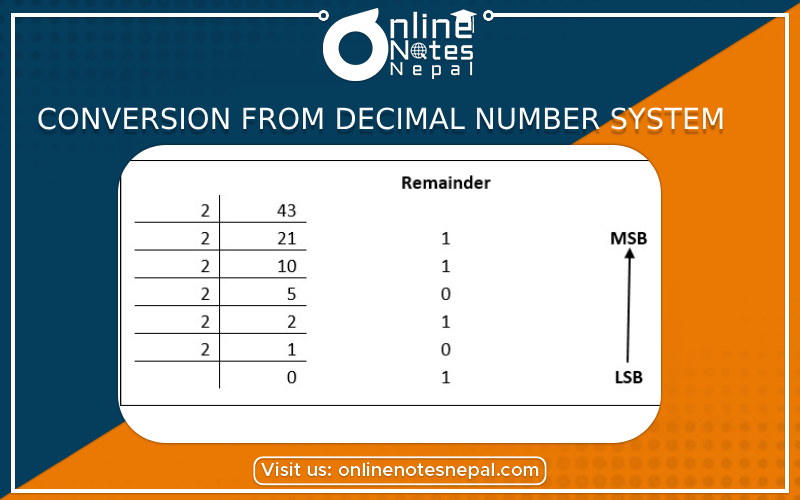Published by: Sujan
Published date: 18 Jun 2021

Conversion from Decimal Number System can be studied in the following topics;
For conversion from a decimal number system to binary, we have to divide the decimal number by 2 repeatedly, until the quotient of zero is obtained. This method of repeated division by 2 is called the ‘double-dabble’ method. The remainders are noted down for each of the division steps. Then the column of the remainder is read in reverse order i.e., from bottom to top order. We try to show the method with an example shown in Example 1.1.
Example 1.1. Convert (26)10 into a binary number.
Solution:
| Division | Quotient | Generated Remainder |
|---|---|---|
| 26/2 | 13 | 0 |
| 13/2 | 6 | 1 |
| 6/2 | 3 | 0 |
| 3/2 | 1 | 1 |
| 1/2 | 0 | 1 |
Hence, the converted binary number is (11010)2.
Similarly, for conversion from a decimal number system to octal, we have to divide the decimal number by 8 repeatedly, until the quotient of zero is obtained. This method of repeated division by 8 is called ‘octal-dabble.’ The remainders are noted down for each of the division steps. Then the column of the remainder is read from bottom to top order, just as in the case of the double-dabble method. We try to illustrate the method with an example shown in Example 1.2.
Example 1.2. Convert (426)10 into an octal number.
Solution:
| Division | Quotient | Generated Remainder |
|---|---|---|
| 426/8 | 53 | 2 |
| 53/8 | 6 | 5 |
| 6/8 | 0 | 6 |
Hence, the converted octal number is (652)8.
The same steps are repeated for conversion from a decimal number system to hexadecimal. Only here we have to divide the decimal number by 16 repeatedly until the quotient of zero is obtained. This method of repeated division by 16 is called ‘hex dabble.’ The remainders are noted down for each of the division steps. Then the column of the remainder is read from bottom to top order as in the two previous cases.
We try to discuss the method with an example shown in Example 1.3.
Example 1.3. Convert (348)10 into a hexadecimal number.
Solution:
| Division | Quotient | Generated Remainder |
|---|---|---|
| 348/16 | 21 | 12 |
| 21/16 | 1 | 5 |
| 1/16 | 0 | 1 |
Hence the converted hexadecimal number is (15C)10.
Shortly,
